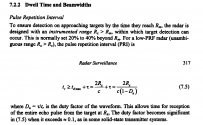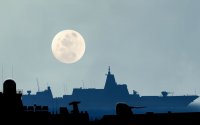So, have anyone make a range estimate for those big phased arrays ? Particularly the 346B.
think i can try make one, with some assumptions tho.
wikipedia states that earlier Type 346 have 4x4 meter antenna and S-band. Assuming array fill factor of say 90%. the 4x4 m array can contain about 4522 TRM assuming operational frequency of 3 GHz. The range of this early types is stated to be at least 400 Km.
The type 346B for Type-055 is stated to have 40% larger array. This corrensponds to area of about 17.59 sqm. Assuming same fill factor, the array would contain 6332 TRM. This is about 1.4 Times.
There is simple 4th root rules of thumb one can follow to calculate range based on the module numbers alone.

The deriviation of above can be read from book "Radar Technique using Array Antenna" by Dietrich Wulfer. and the way it is possible to do with such simplicity can be read in Richard G Curry's "Radar System Performance Modeling".
Now with reference range of 400 Km. Assuming same module architecture and same cooling the 346B with that assumption will have increased range with factor of (1.4^3)^(1/4) = 1.28 Times or 514 km.
Now with change of cooling system, what kind of range we can get ? This requires deeper look in cooling capacity. But for sake of simplicity let's assume the designers were able to provide 3 times more power compared to the earlier design with new liquid cooling system. The equations can then be adjusted by adding the power factor in it. Thus :
((1.4^3)*(3))^(1/4) = 1.693 or 1.7 times or 680 Km.
To make deeper insight however more have to be assumed e.g Target RCS and probability of detection which requires target model (e.g Swerling 1 or 2). Then SNR can be determined and used as a basis to estimate sensitivity (using loop gain method) and accuracy( range, doppler and monopulse) of the radar.
An article written by one of the designers of the array, now retired and living in Canada, states around 4700 elements for what is to be the Type 346 array on the 052C. So you are close.
Range estimation is more nuanced than that. For example, in the West, radars are often stated by Instrumented Range. This is based on the length of the longest pulse duty cycle that allows for a return to allow for computing unambiguous range. When the Russians mention range, its even more nuanced because there is an RCS context to it. 300km for a 2m2 RCS object is not the same performance as 300km for a 10m2 RCS, its superior.



